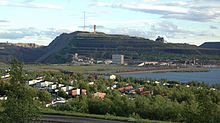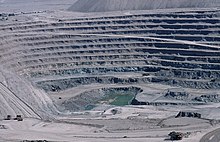Mine
All surface and underground operating facilities and systems at a location for the extraction , extraction and processing of mineral resources are referred to as mines . Mines are also called pit or colliery .
A mine includes all structures, systems and facilities above ground that are used for the extraction, processing, storage and loading of raw materials and tailings , as well as facilities and facilities for administration and for employees. In addition, a mine includes all associated underground systems and facilities, in particular all shafts , routes and tunnels that are referred to as pit construction .
In a broader sense, it also includes excavations "above ground" ( opencast mining ) and deep drilling .
Types
Underground mines
The development of a deposit by an underground mine begins with the alignment and the subsequent sinking of the shafts or the lengthening of the tunnels. They are the link between Earth's surface and the deposit "on site" and for the manhole or track promotion of degradation , displacement and material manriding of persons and the drainage and weather guidance necessary.
The choice of shaft location influences the manufacturing and operating costs of the underground mine. The routes ( straightening routes and cross passages ) to the stores ( seams , tunnels , floors ) of the raw materials to be conveyed go from the shafts . The entirety of all underground cavities is called a pit building .
The daytime facilities of a mine, ie the parts located “above ground”, are: the headframe , the bucket , systems for ventilation ( ventilation ), for water retention and cleaning and the processing systems.
Opencast mines
Extraction of bulk raw materials and fossil fuels by large excavators ( wheel loaders , bucket wheel excavators , bucket chain excavators , etc.). If necessary, crushing in crushers . Removal with dump trucks or conveyor belts .
- Large open-cast mines (especially for lignite , oil shale , oil sands , ores , minerals )
- "Pits" ( gravel pits , sand pits ) or "Kuhlen" ( clay pits ), especially for loose rock
- " Quarries " ( quarries , limestone quarries ) for solid rock
- "Stitch" ( peat stitch , clay stitch ) for doughy rocks
- Prospecting for dignified precious metals, precious stones , ...
- In the broadest sense, they also include quarry ponds, where floating dredgers are used to extract bulk raw materials from the bottom of a lake.
Drilling
- Drilling for oil and / or natural gas
- Well drilling for groundwater
- Bores for the solution mining of salt domes
Historical development

The oldest mine discovered so far is a flint mine in Nazlet Khater in Upper Egypt , where flint was mined underground over 30,000 years ago.
In ancient times, the mass production of metals could mostly only be organized by state-organized large companies and slave or forced labor. Private entrepreneurs were also active as tenants, as in Laurion . There were various ores (partly underground, partly also in opencast mining), u. a. also silver, mined and employed a total of 20,000 slaves and prisoners. For the drainage of the mines could since the 3rd century BC BC the Archimedean screw served.
In Germany mining also began with Stone Age flint mines. At the Rammelsberg near Goslar, ore mining was already carried out in the Bronze Age. The associated mine was recognized as a UNESCO World Heritage Site in 1992, together with the Goslar old town, and later expanded to include the Samson mine in St. Andreasberg . The Rammelsberg museum and visitor mine are the anchor points of the European Route of Industrial Culture (ERIH).
literature
- Walter Bischoff , Heinz Bramann: The little mining dictionary . Ed .: Westfälische Berggewerkschaftskasse Bochum. 7th edition. Glückauf Verlag, Essen 1988, ISBN 3-7739-0501-7 .
- The knowledge of the 20th century . First volume. Publishing house for knowledge and education, Bertelsmann publishing group, Gütersloh 1971.
- Helmut Wilsdorf: Cultural history of mining . An illustrated journey through times and continents. Glückauf Verlag, Essen 1987, ISBN 3-7739-0476-2 .
- Wilhelm and Gertrude Hermann: The old mines on the Ruhr. Past and future of a key technology. With a catalog of the "life stories" of 477 mines (series Die Blauen Bücher ). Langewiesche publishing house, Königstein im Taunus, 6th, expanded and updated edition. 2008, ISBN 978-3-7845-6994-9 .
Web links
Individual evidence
- ↑ §2.1 BBerG
- ↑ Jürgen Bollmann, Annette Lipinski, Wolf-Günther Koch (eds.): Lexicon of cartography and geomatics . Spectrum Academic Publishing House, 2005, ISBN 978-3-8274-1672-8 .
- ↑ Alice Leplongeon, David Pleurdeau: The Upper Palaeolithic Lithic Industry of Nazlet Khater 4 (Egypt) . Implications for the Stone Age / Palaeolithic of Northeastern Africa. In: African Archaeological Review . tape 3 , no. 28 , 2011, p. 213-236 , doi : 10.1007 / s10437-011-9100-x .
- ^ Michael Rostovtzeff: Social and economic history of the Hellenistic world. Volume 2, Darmstadt 1998, p. 978 f.



